Hows it going, thank you for joining me on this build. One day I was watching a nature show and saw this deep sea scene with hot volcanic spouts and shrimps on them and I said "I want one" and on the journey I went to find me a cave tank. I already had a pretty good feeling that this wasn't going to be something you can buy and so I decided to make me one. I took me a couple weeks to fully complete, but in the end it came out great and I loved every second of it. This is that build and how I went about it.
Ok where to start, first lets talk a little foam yea. There are all kinds of foam blocks and sheets out there, some harder, some softer, some with big balls compacted together some with tiny balls compacted together and some (the kind i like most) is solid. For some foam might be an easy thing to get a hold of, or if your like me you tend to try to save the big blocks you come across in packaging for builds like this (cheapest and easiest way sometimes). One foam I like to use and will be using in this tutorial, but is a little more involved is pink insulation foam from home depot. Its carve-able, glue-able, stack-able, and can cove larger areas at a time, but you can use any foam that works for the style in which you are building as long as it doesn't contain harsh chemicals.
Right....now lets go through some essentials shall we. Some of the things you will need for this build is a tank, some foam, 100% silicone, a knife or carving tools, Resurfacing cement, cement coloring to match the environment in which you want to mimic or none at all if you choose to allow natural coloring to take over. Depending on the type of environment you are creating you may also need things like air pumps, air stones, filters, and possibly even chicken wire. For this build I add an air pimp, some air lines a filter and some air stones.
First choose the tank that works for what you are trying to replicate.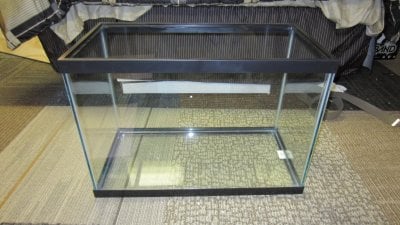
I chose a 20 gallon high because I wanted the depth more than length. I also chose this one over a 10 gallon because once all said and done you loose space and water volume with in the tank due to cement and foam and I wanted at least 10 gallons of space. This is where we learn the first lesson of any build and the absolute "Golden Rule"....Always Compensate (make up for something unwelcome or unpleasant by exerting an opposite force or effect.)
What I mean by this is When you build a hood for your tank for example, you cant measure the top of the tank and build to those measurements you have to compensate for the width of the product used to build the hood then you have to compensate again with a longer measurement of the width of the tank. If done correctly your hood will fit.
(example: If you have a tank that is 24" wide that makes it 24 3/8" wide with the black plastic rim. Now if you were to measure a piece of wood for that length you would have to measure it to 27 1/4" (if using 2x2's like I did on another build) to make the inside diameter of the frame built to fit your 24 3/8" wide.)
Now on to the foam......once you have your tank and hopefully an idea of what you want to build its time to carve some foam. The thickness of your foam depends on your design and space wanting to keep. I chose a sheet of the thickest foam I could buy in this form, I think its something like 1" thick or something like that possibly a little less.
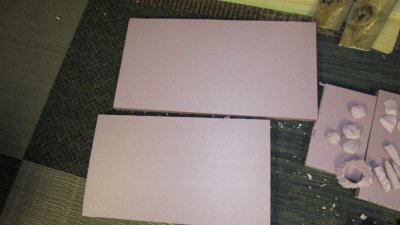
I first start by cutting sheets to fit all sides of the tank and for this specific build I even cut a piece to use for the top of the cave system. Remember to compensate for the width of the foam so your pieces come together as uniform as possible. The measurements will depend on if your butting the side to the back or the back to the sides.
Here a picture for the reference in which I made to help you understand...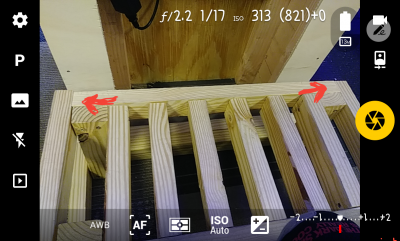
The red arrows are pointing to a joint in which the back is butted up to the side pieces. What its indicating is if this stool in the picture was not to exceed 26 1/4" long then I would have to measure that back length to only 23 3/8" and allow the other joining pieces to make up the difference.
Now that you have those measured out set them aside for now and grab all the other pieces of foam that are not being used and lets begin to have some fun....Here comes some fun in carving and waiting lol.....
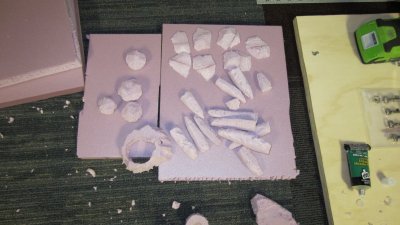
Waiting? why waiting you ask, well sometimes...specially when using this type of foam your pieces are not thick enough to carve what you need from them and you will need to glue them together. That is where the 100% silicone comes in. Now a very IMPORTANT thing to remember is to ruff up the surface with sand paper before attempting to glue together. The Silicone and other glues while will glue the shiny surfaces together initially, they will also peel off that shiny surface easily too. To counter act this just take a piece of sand paper and rub off that shiny surface or at very least ruff up the surface before gluing. Once glued together and dried you can proceed to carve the pieces to needed for your tank. some pieces were carved to add texture to my surface foam where others were actual decor for the tank.
Woo that been some work so far huh??...lol were just getting started. Now this part can be done while you have pieces drying after being glued doesnt matter (I do it while I have Pieces drying), but we are going to go back to those back wall and side pieces we cut earlier, and give them a carve. In this specific tank I actually carved a floor for this tank as well.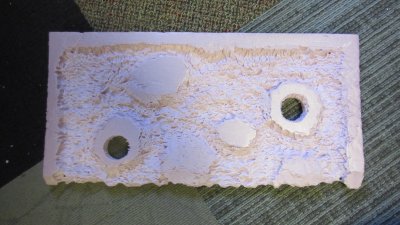
This is the bottom all carved out and textured. The holes that you see all the way through it are for the volcanic spouts that will be built in as we go. Ok, above I mentioned that I got some air stones and a pump for my volcanic spouts.
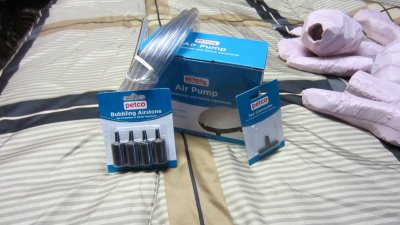
I used one T to provide two air stones with air from a little air pump. I also got a one way valve for the air so nothing can back up the tube.....once you got your plumbing ready its time to make the accommodations for it.
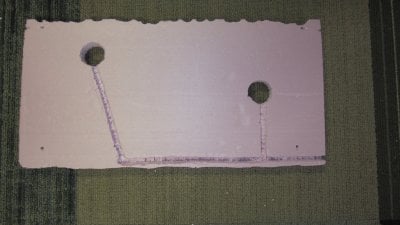
Here you see the under side of the carved floor and the channels carved for the air lines and stones.
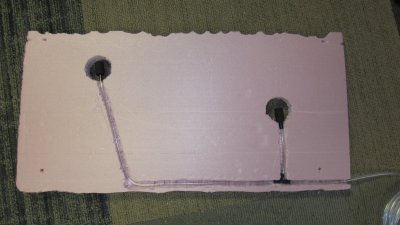
Here it what it looks like after its ran and in place.
What about these volcanic spouts where are they how did you make them....They go a little like this...
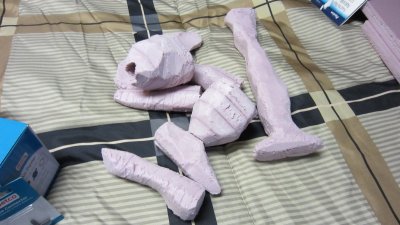
I don't have the best images of them but here they are with other carved stalagmites and stalactites. What I did to carve them was to,... well scroll back up to the image with the pieces laying on a sheet of foam. In that image there is a piece of foam carved into a ring, well I made a bunch of these all different sizes and glued them together in a cone shape. Once they were dried I could carve them without a problem. Since I started with them hollow they didn't give me much in the way of trouble while carving.
Before we go putting together this thing like the puzzle it was built into I wanna go back to the carving of the bottom and the sides to show case an idea you can do with a little imagination.
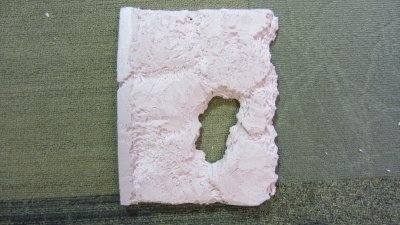
This is one of the sides for the tank, I carved a window hole into the side so while it was on a regular stand you could use it as a side window like a display in a aquarium museum....but its real use was going to be for a little light. With the type of stand I want to build for this thing it would render this window useless and I knew that making it, but what I planed on doing with it was putting a led light against the glass on the outside causing a dem light to shine through this hole like it was a hole to the outside.
YAY!!!! We made it to the best part! Its time to put the puzzle together and see what you got......Once my puzzle was together this is what I had for this Specific tank.
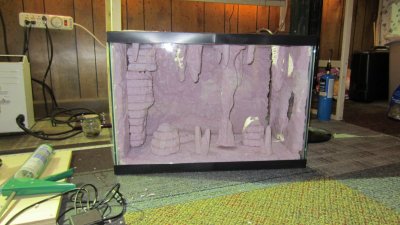
This is the halfway point you made it, but now its time to learn a few things. First I hope you rubbed off all shiny layers of foam because if not your gonna have a rough time with though patches.
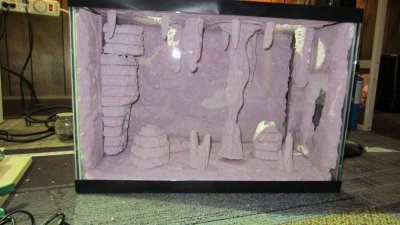
Gluing the artificial back ground together should be pretty straight forward, by this point you can visibly see what your going for and can probably bring it together quickly but take your time. One once your done it needs to dry for 24 hrs 8 at the min, so by taking your time you will make it look good and give you some quality time with your build. I want to talk about what we are seeing in this image, for the first time we can see the top I carved for this tank. I want to first point out that half of the top on the (your right) with the piece of foam that connect the top to the bottom is glued in and is not removable. The (your Left) side of the top is removable for better access to the filter...lol yes filter. If you have noticed it yet the wall growth on the side without the window is actually a filter with foam around it to hide it. Kind of built like the volcanic spouts I built a cone to fit and glued it together and craved it out. It looks much more hidden and believable once covered in some cement and colored to match. The top is also made with holes in the top to allow some light through and project light into cretin places into the tank while keeping it low light. I made it this way for both effect and for blind cave species that would other wise be effected by light.
Resurfacing cement....What to know How to use it....
I have been using resurfacing cement for a long time now and when cleaned correctly has no ill effects on aquatic life, but if not taken seriously it can kill anything you put in it for a little while...
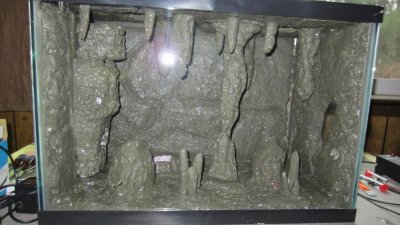
To start you have to start with a very watered down mix, the idea is to just kinda cover all the foam with some runny mix not so runny its just water but runny enough that it just leaves a sandy grit behind. You want this to coat all the foam lightly causing it to become rough when dried, almost like you applied liquid sand paper to it and allowed it to dry. This will then allow the other thicker mixes to stick and bond to the foam with a better hold than if you skipped that step. If you did not take all the shiny layers off the exposed unglued foam then you will have a harder time getting this first layer or any layer to stick to that area. It can happen but its just easier to take off the shiny layer.
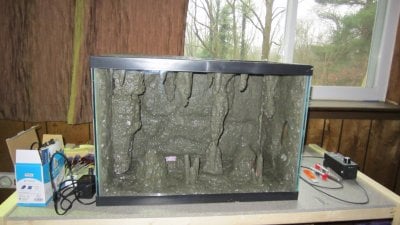
It is very IMPORTANT to allow every layer of applied cement time to dry before applying another layer to the foam. Each layer of mix applied should be thicker than the last until the desired thickness is achieved. If you start with a runny mix thicker than the (Sandpaper coating) but runny enough to go into small cracks you can start to refill areas and coat areas that are otherwise hard to reach, and after a few layers it will thicken on itself. Take your time do not rush this process, if you do it can result in thin areas that are prone to breakage or the possibility of a blemish of sorts causing an eye sore that will forever ruin your tank to you. The more time you take the better your tank will look. Its usually 1 application a day and can take over a week to complete an entire setup, it just depends on size of display.
Welp here we are folks you have made it! You've applied your last coat of cement you have achieved your desired thickness. Now its time to...."what, your last coat has been drying for the past 24hrs?" ok well then we will move on to filling your tank. Before your finished product can look like this...

You have to soak and wash it really well. Resurfacing cement has the tendencies to make water acidic. So what I do to combat this is use a common house hold acid...lol...yes an acid..vinegar, house hold vinegar. Safest thing you can use without messing up your hard work. Cement is very porous and will soak up chemicals that it touches leaving a lasting effect on your water and display so use nothing but vinegar, baking soda, and water. Spray some vinegar on the cement and let it soak in for a few moments then proceed to wash your tank out with clean water. Put the tank up somewhere off the ground (make it easier to empty later) and fill it with water. let it soak for a few hrs then drain it. Do this an many times as you can stand doing it and in the process of doing this add a little baking soda to the water during the soak periods to help keep up ph an in turn combat the acidity of the cement. Once you feel its clean set it up where you would like it to go and add water, allow the tank to cycle all while keeping a close eye on the water conditions. It could take a large number of water changes (or washes) before it wants to maintain a water quality that is suitable for the tank to cycle and maintain life. If done correctly and with the proper washings you can get a cycle going in a tank with this cement in a week or so. I personally made a different type of display for a 20 high only doing the back and sides and had life in that tank (fish and plants) after a couple weeks of cycling. It all largely depends on the amount of cement used and length of time left to dry before adding water to the tank.
I thank you for following this build and hope you have learned a thing or two to bring back to your projects and make them awesome. Id love to see your builds and hear about some of your techniques. Please feel free to ask any of your questions you may have or would like to know and I'll do my best to help you with them.
Ok where to start, first lets talk a little foam yea. There are all kinds of foam blocks and sheets out there, some harder, some softer, some with big balls compacted together some with tiny balls compacted together and some (the kind i like most) is solid. For some foam might be an easy thing to get a hold of, or if your like me you tend to try to save the big blocks you come across in packaging for builds like this (cheapest and easiest way sometimes). One foam I like to use and will be using in this tutorial, but is a little more involved is pink insulation foam from home depot. Its carve-able, glue-able, stack-able, and can cove larger areas at a time, but you can use any foam that works for the style in which you are building as long as it doesn't contain harsh chemicals.
Right....now lets go through some essentials shall we. Some of the things you will need for this build is a tank, some foam, 100% silicone, a knife or carving tools, Resurfacing cement, cement coloring to match the environment in which you want to mimic or none at all if you choose to allow natural coloring to take over. Depending on the type of environment you are creating you may also need things like air pumps, air stones, filters, and possibly even chicken wire. For this build I add an air pimp, some air lines a filter and some air stones.
First choose the tank that works for what you are trying to replicate.

I chose a 20 gallon high because I wanted the depth more than length. I also chose this one over a 10 gallon because once all said and done you loose space and water volume with in the tank due to cement and foam and I wanted at least 10 gallons of space. This is where we learn the first lesson of any build and the absolute "Golden Rule"....Always Compensate (make up for something unwelcome or unpleasant by exerting an opposite force or effect.)
What I mean by this is When you build a hood for your tank for example, you cant measure the top of the tank and build to those measurements you have to compensate for the width of the product used to build the hood then you have to compensate again with a longer measurement of the width of the tank. If done correctly your hood will fit.
(example: If you have a tank that is 24" wide that makes it 24 3/8" wide with the black plastic rim. Now if you were to measure a piece of wood for that length you would have to measure it to 27 1/4" (if using 2x2's like I did on another build) to make the inside diameter of the frame built to fit your 24 3/8" wide.)
Now on to the foam......once you have your tank and hopefully an idea of what you want to build its time to carve some foam. The thickness of your foam depends on your design and space wanting to keep. I chose a sheet of the thickest foam I could buy in this form, I think its something like 1" thick or something like that possibly a little less.

I first start by cutting sheets to fit all sides of the tank and for this specific build I even cut a piece to use for the top of the cave system. Remember to compensate for the width of the foam so your pieces come together as uniform as possible. The measurements will depend on if your butting the side to the back or the back to the sides.
Here a picture for the reference in which I made to help you understand...

The red arrows are pointing to a joint in which the back is butted up to the side pieces. What its indicating is if this stool in the picture was not to exceed 26 1/4" long then I would have to measure that back length to only 23 3/8" and allow the other joining pieces to make up the difference.
Now that you have those measured out set them aside for now and grab all the other pieces of foam that are not being used and lets begin to have some fun....Here comes some fun in carving and waiting lol.....

Waiting? why waiting you ask, well sometimes...specially when using this type of foam your pieces are not thick enough to carve what you need from them and you will need to glue them together. That is where the 100% silicone comes in. Now a very IMPORTANT thing to remember is to ruff up the surface with sand paper before attempting to glue together. The Silicone and other glues while will glue the shiny surfaces together initially, they will also peel off that shiny surface easily too. To counter act this just take a piece of sand paper and rub off that shiny surface or at very least ruff up the surface before gluing. Once glued together and dried you can proceed to carve the pieces to needed for your tank. some pieces were carved to add texture to my surface foam where others were actual decor for the tank.
Woo that been some work so far huh??...lol were just getting started. Now this part can be done while you have pieces drying after being glued doesnt matter (I do it while I have Pieces drying), but we are going to go back to those back wall and side pieces we cut earlier, and give them a carve. In this specific tank I actually carved a floor for this tank as well.

This is the bottom all carved out and textured. The holes that you see all the way through it are for the volcanic spouts that will be built in as we go. Ok, above I mentioned that I got some air stones and a pump for my volcanic spouts.

I used one T to provide two air stones with air from a little air pump. I also got a one way valve for the air so nothing can back up the tube.....once you got your plumbing ready its time to make the accommodations for it.

Here you see the under side of the carved floor and the channels carved for the air lines and stones.

Here it what it looks like after its ran and in place.
What about these volcanic spouts where are they how did you make them....They go a little like this...

I don't have the best images of them but here they are with other carved stalagmites and stalactites. What I did to carve them was to,... well scroll back up to the image with the pieces laying on a sheet of foam. In that image there is a piece of foam carved into a ring, well I made a bunch of these all different sizes and glued them together in a cone shape. Once they were dried I could carve them without a problem. Since I started with them hollow they didn't give me much in the way of trouble while carving.
Before we go putting together this thing like the puzzle it was built into I wanna go back to the carving of the bottom and the sides to show case an idea you can do with a little imagination.

This is one of the sides for the tank, I carved a window hole into the side so while it was on a regular stand you could use it as a side window like a display in a aquarium museum....but its real use was going to be for a little light. With the type of stand I want to build for this thing it would render this window useless and I knew that making it, but what I planed on doing with it was putting a led light against the glass on the outside causing a dem light to shine through this hole like it was a hole to the outside.
YAY!!!! We made it to the best part! Its time to put the puzzle together and see what you got......Once my puzzle was together this is what I had for this Specific tank.

This is the halfway point you made it, but now its time to learn a few things. First I hope you rubbed off all shiny layers of foam because if not your gonna have a rough time with though patches.

Gluing the artificial back ground together should be pretty straight forward, by this point you can visibly see what your going for and can probably bring it together quickly but take your time. One once your done it needs to dry for 24 hrs 8 at the min, so by taking your time you will make it look good and give you some quality time with your build. I want to talk about what we are seeing in this image, for the first time we can see the top I carved for this tank. I want to first point out that half of the top on the (your right) with the piece of foam that connect the top to the bottom is glued in and is not removable. The (your Left) side of the top is removable for better access to the filter...lol yes filter. If you have noticed it yet the wall growth on the side without the window is actually a filter with foam around it to hide it. Kind of built like the volcanic spouts I built a cone to fit and glued it together and craved it out. It looks much more hidden and believable once covered in some cement and colored to match. The top is also made with holes in the top to allow some light through and project light into cretin places into the tank while keeping it low light. I made it this way for both effect and for blind cave species that would other wise be effected by light.
Resurfacing cement....What to know How to use it....
I have been using resurfacing cement for a long time now and when cleaned correctly has no ill effects on aquatic life, but if not taken seriously it can kill anything you put in it for a little while...

To start you have to start with a very watered down mix, the idea is to just kinda cover all the foam with some runny mix not so runny its just water but runny enough that it just leaves a sandy grit behind. You want this to coat all the foam lightly causing it to become rough when dried, almost like you applied liquid sand paper to it and allowed it to dry. This will then allow the other thicker mixes to stick and bond to the foam with a better hold than if you skipped that step. If you did not take all the shiny layers off the exposed unglued foam then you will have a harder time getting this first layer or any layer to stick to that area. It can happen but its just easier to take off the shiny layer.

It is very IMPORTANT to allow every layer of applied cement time to dry before applying another layer to the foam. Each layer of mix applied should be thicker than the last until the desired thickness is achieved. If you start with a runny mix thicker than the (Sandpaper coating) but runny enough to go into small cracks you can start to refill areas and coat areas that are otherwise hard to reach, and after a few layers it will thicken on itself. Take your time do not rush this process, if you do it can result in thin areas that are prone to breakage or the possibility of a blemish of sorts causing an eye sore that will forever ruin your tank to you. The more time you take the better your tank will look. Its usually 1 application a day and can take over a week to complete an entire setup, it just depends on size of display.
Welp here we are folks you have made it! You've applied your last coat of cement you have achieved your desired thickness. Now its time to...."what, your last coat has been drying for the past 24hrs?" ok well then we will move on to filling your tank. Before your finished product can look like this...
You have to soak and wash it really well. Resurfacing cement has the tendencies to make water acidic. So what I do to combat this is use a common house hold acid...lol...yes an acid..vinegar, house hold vinegar. Safest thing you can use without messing up your hard work. Cement is very porous and will soak up chemicals that it touches leaving a lasting effect on your water and display so use nothing but vinegar, baking soda, and water. Spray some vinegar on the cement and let it soak in for a few moments then proceed to wash your tank out with clean water. Put the tank up somewhere off the ground (make it easier to empty later) and fill it with water. let it soak for a few hrs then drain it. Do this an many times as you can stand doing it and in the process of doing this add a little baking soda to the water during the soak periods to help keep up ph an in turn combat the acidity of the cement. Once you feel its clean set it up where you would like it to go and add water, allow the tank to cycle all while keeping a close eye on the water conditions. It could take a large number of water changes (or washes) before it wants to maintain a water quality that is suitable for the tank to cycle and maintain life. If done correctly and with the proper washings you can get a cycle going in a tank with this cement in a week or so. I personally made a different type of display for a 20 high only doing the back and sides and had life in that tank (fish and plants) after a couple weeks of cycling. It all largely depends on the amount of cement used and length of time left to dry before adding water to the tank.
I thank you for following this build and hope you have learned a thing or two to bring back to your projects and make them awesome. Id love to see your builds and hear about some of your techniques. Please feel free to ask any of your questions you may have or would like to know and I'll do my best to help you with them.












